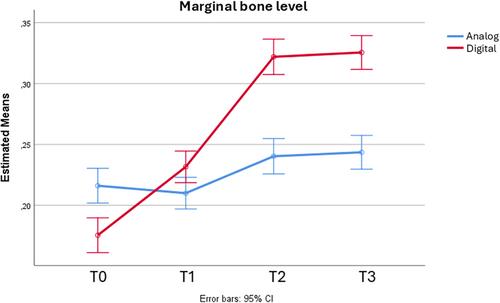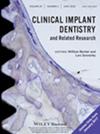Marginal Bone Level Changes in Full-Arch Rehabilitation: Digital Versus Analog Protocols—A 5-Year Retrospective Study
Abstract
Introduction
This retrospective study compares the clinical outcomes of analog impressions versus intraoral scanning in full-arch immediate loading rehabilitations. Specifically, it evaluates peri-implant marginal bone level (MBL) changes at different time intervals (implant placement, loading, and at 2 and 5 years), as well as rates of mechanical and prosthetic complications.
Materials and Methods
The study included 62 patients who underwent full-arch rehabilitation with immediate implant placement between 2019 and 2020. Patients were divided into two groups: analog impression and digital intraoral scanning. All patients were rehabilitated with fixed titanium-PMMA screw retained restorations. Bone level was assessed through standardized intraoral radiographs at key time points. Additional parameters recorded included procedural time, prosthetic complications, and implant failures. Statistical analyses involved repeated measures ANOVA and post hoc Bonferroni tests.
Results
The follow-up period was 5 years. Implant survival was 99.6%. No significant differences were found in prosthetic complications. MBL was slightly higher in the analog group at baseline (mean = 0.21, SD = 0.04 vs. digital mean = 0.17, SD = 0.04, t-test p-value < 0.001) than in the digital group. Despite this, the overall bone loss remained within clinically acceptable limits during the follow-up period. Digital impressions significantly reduced procedural time compared to analog methods.
Conclusions
Both impression techniques provided satisfactory clinical outcomes. Digital impressions demonstrated efficiency advantages but were associated with slightly greater bone loss over time. Analog impressions remain a reliable standard for full-arch immediate loading rehabilitations, though digital methods show promise for improved patient experience. Further randomized, long-term studies are needed.
Clinical Significance
Digital impressions offer a faster and more comfortable workflow for full-arch immediate loading rehabilitations, potentially improving patient compliance. However, their association with slightly greater bone loss warrants further investigation to optimize long-term stability.


 求助内容:
求助内容: 应助结果提醒方式:
应助结果提醒方式:


